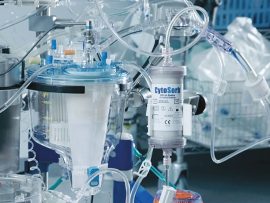Abstract Introduction Heparin is usually added to infant cardiopulmonary bypass circuit primes. Ultrafiltration is often used to minimise prime volume before commencing bypass. The extent of heparin removal from bypass..
Read MoreAbstract Objective This scoping review aimed to examine current literature on the use of point-of-care ultrasound (POCUS) in paediatric patients supported by extracorporeal membrane oxygenation (ECMO). It assessed existing evidence,..
Read MoreAbstract Background: Infants with congenital heart disease (CHD) frequently undergo surgery during their first year of life. Infants undergoing CHD surgery experience systemic inflammation and haemodilution that can deplete circulating..
Read MoreScientific Explanation of Tetralogy of Fallot With Pulmonary Atresia and the Therapeutic Role of Dr. Sam Zeraatian-Nejad Davani 1. Introduction to the Disease: Tetralogy of Fallot (TOF) Tetralogy of Fallot..
Read MoreAbstract Introduction Cardiopulmonary bypass (CPB) plays a central role in pediatric cardiac surgery, yet standardized quality indicators (QIs) specific to pediatric practice remain underutilized across institutions. Methods A comprehensive review..
Read MoreAbstract Purpose Postoperative bleeding is a major concern in pediatric cardiac surgery under cardiopulmonary bypass (CPB). The comparative utility of viscoelastic testing and central laboratory assays for predicting bleeding risk..
Read MoreAbstract Remote ischemic preconditioning (RIPreC) has been regarded as a promising strategy to reduce ischemia-reperfusion injury to the heart and other organs caused by cardiopulmonary bypass. While RIPreC has demonstrated..
Read MoreAbstract Introduction Neonatal aortic arch surgery is associated with neurological morbidity of varying severity which is detected and potentially limited through neuroprotective strategies. We conducted a survey of healthcare professionals..
Read MoreAbstract Low cardiac output syndrome (LCOS) is defined by an insufficient cardiac output to meet metabolic demands, leading to tissue hypoperfusion and potential organ dysfunction. Although it affects up to 42%..
Read MoreAbstract Objective This study evaluated thrombus formation and its impact on outcomes in neonates and early infants undergoing congenital heart surgery. Methods Neonates and early infants (≤90 days) undergoing congenital..
Read MoreAbstract Background Mortality in congenital diaphragmatic hernia (CDH) approximates 30 %. Both severe lung hypoplasia and other anomalies contribute to demise regardless of repair and/or extracorporeal membrane oxygenation (ECMO). We..
Read MoreAbstract Background Maintaining optimal anesthetic depth during cardiopulmonary bypass (CPB) in pediatric patients is challenging due to altered physiology and unreliable conventional monitoring. Entropy, a processed electroencephalogram metric, offers a..
Read MoreAbstract Background Open cardiac surgery involving cardiopulmonary bypass (CPB) triggers a systemic inflammatory response that significantly affects clinical outcomes. However, the dynamics and specific roles of cytokine release after CPB..
Read MoreAbstract Background Health-related (HRQL) is an important outcome measure in . We aimed to determine HRQL of children who underwent complex cardiac surgery at age ≤6 weeks with follow-up at age 4-5..
Read MoreAbstract Background: The applicability of four major traditional in-hospital mortality models in the Chinese setting is unclear due to disease spectrum and population heterogeneity. This study aimed to test the..
Read MoreAbstract Objective:This study aimed to evaluate school-age neurodevelopmental outcomes among children with single ventricle heart disease who underwent neonatal Norwood operation with regional cerebral perfusion compared to deep hypothermic circulatory..
Read MoreAbstract Allogeneic red blood cells (RBCs) are commonly used for cardiopulmonary bypass (CPB) circuit priming in congenital heart surgery. While convection-based pre-bypass ultrafiltration (PBUF) corrects acid–base, electrolyte, and metabolite imbalances,..
Read MoreAbstract Background Despite the widespread adoption of selective antegrade cerebral perfusion (SACP) for neonatal aortic arch reconstruction, significant variability in techniques persists across institutions, thus reflecting limited supporting data and..
Read MoreAbstract Therapeutic plasma exchange (TPE) in pediatric patients presents many challenges, including management of a large extracorporeal volume (ECV) and calcium replacement for patients who may not be able to..
Read MoreAbstract Background The experience of a percutaneous microaxial (Impella) in children with is limited. The primary objective of this study was to review our institutional clinical outcomes of Impella use in children..
Read MoreAbstract Aims Academic achievement of children with congenital heart disease (CHD) has not been comprehensively studied across the entire CHD severity spectrum. Methods and results Through nationwide registries, we identified..
Read MoreAbstract Congenital diaphragmatic hernia (CDH) is a rare and severe malformation that can lead to life-threatening postnatal physiological challenges which may require lifesaving extracorporeal membrane oxygenation (ECMO) support, sometimes more..
Read MoreAbstract Background Young patients may survive accidental deep hypothermia with prolonged asystolic circulatory arrest because of protective effects of cold. Case Summary An 8-year-old boy fell through pond ice and..
Read MoreAbstract Background Delayed sternal closure (DSC) is a well-established management strategy following complex congenital cardiac surgery that is used to mitigate postoperative hemodynamic and respiratory instability. It is mostly used..
Read MoreAbstract Background There is geographic disparity in the provision of Pediatric and Congenital Heart Disease (PCHD) services; Africa accounts for only 1% of global cardiothoracic surgical capacity. Methods We conducted..
Read MoreAbstract To investigate the feasibility of regional oxygen saturation (rSO2) monitoring for preventing acute lung injury (ALI)/acute respiratory distress syndrome (ARDS) caused by cardiopulmonary bypass (CPB) in infants undergoing ventricular..
Read MoreAbstract Background: The gold standard for treatment of patients with end-stage heart failure remains . Time spent on the active waiting list, notably for patients, contributes to alarmingly high mortality. Donation after..
Read MoreAbstract Objective To describe cardiac arrest during anesthesia care provided by a pediatric cardiac anesthesiologist in patients with congenital heart disease and identify predictors of outcome. Design Retrospective chart review...
Read MoreAbstract Purpose Extracorporeal cardiopulmonary resuscitation (ECPR) is an advanced resuscitation therapy for cardiopulmonary arrest refractory to standard CPR. ECPR treatment recommendations are not supported by strong evidence, and institutional criteria..
Read MoreAbstract This study aimed to assess whether the proinflammatory markers procalcitonin (PCT), C-reactive protein (CRP), or interleukin 6 (IL-6) are associated with mortality in neonates with congenital diaphragmatic hernia (CDH)..
Read More












